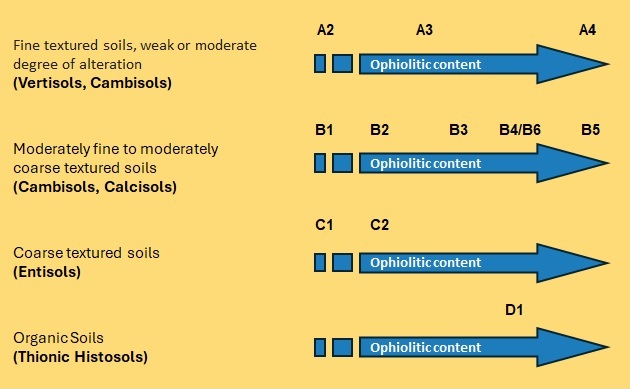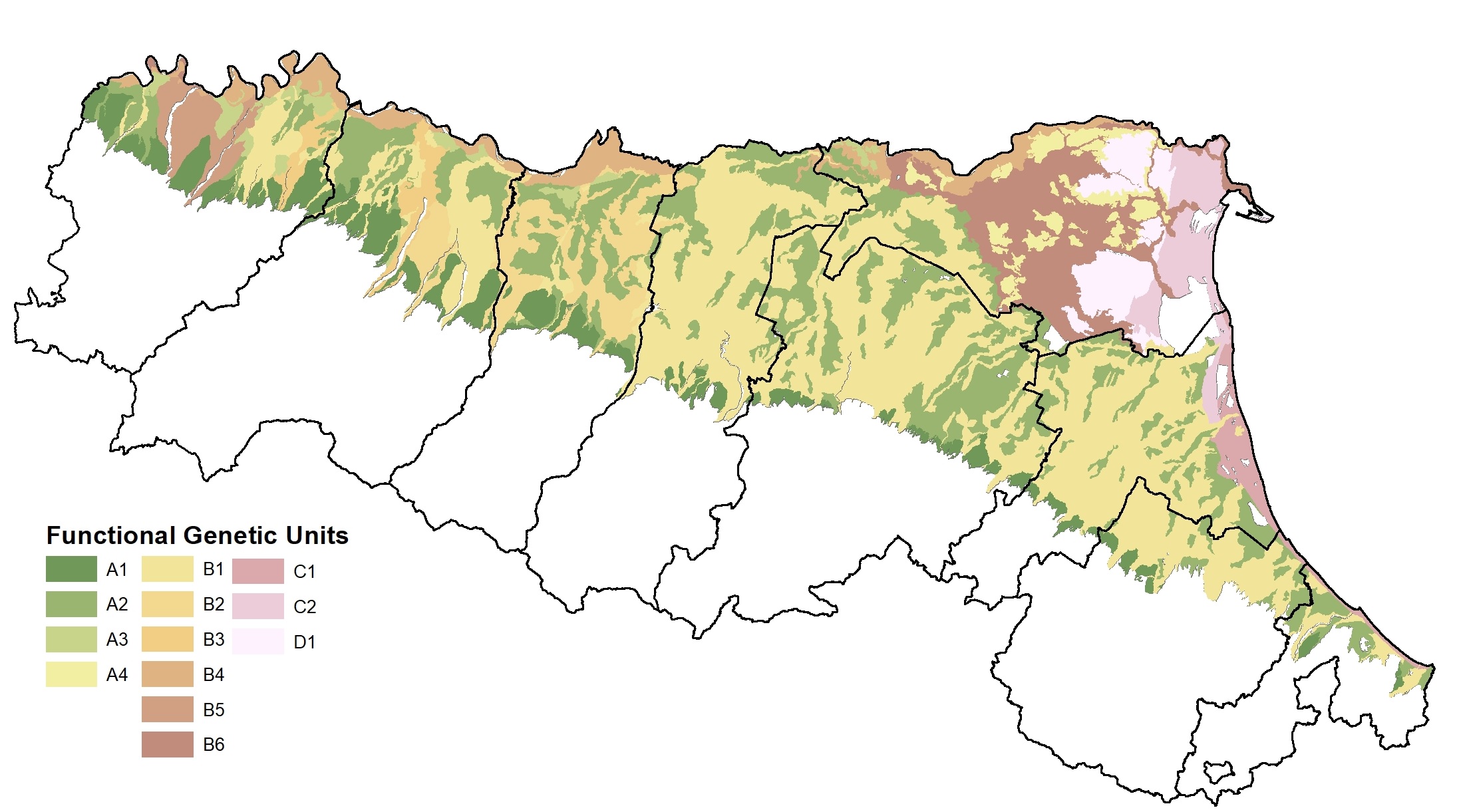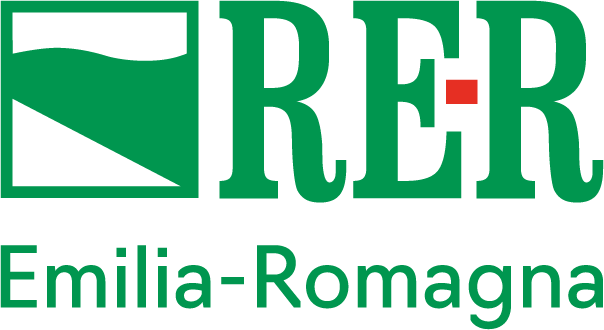Functional genetic units
Soil groups with different heavy metal and metalloid content
One of the main factors influencing the natural distribution of metals and metalloids in soils is the composition of the rocks in the sediment source areas where soils are formed. In the specific case of the Emilia-Romagna plain, which is an example of a multi-source system fed to the south by the Apennine watercourses and along the W-E axis by the Po River (which in turn collects sedimentary contributions from the west and north of much of the Alpine arc), lithological differences in the outcropping units in individual drainage basins are significantly reflected in the geochemical composition of the materials transported downstream by the watercourses.
For the purpose of geochemical mapping, the soils of the Emilia-Romagna plain have been grouped into 13 functional genetic units (FGUs), named with a combination of letters and numbers (see Figure 1 and Table 1).

Figure 1. The letters (A, B, C, D) identify the texture classes, the numbers the ophiolite content

Figure 2. Spatial distribution of FGUs in the Emilia-Romagna plain
UNITS | SOILS | SEDIMENT ORIGIN | ENVIRONMENTAL COMPLEX, DEPOSITIONAL ENVIRONMENT |
|---|---|---|---|
A1 | Medium to fine-textured soils, with a high degree of weathering. Stagnic Luvisols, Vertic Cambisols | Mixed, Apennine basins with absent to high ophiolitic component. | Alluvial fan, interconoid and river terrace / undifferentiated deposits |
A2 | Fine-textured soils, with a weak or moderate degree of weathering. Vertic Cambisols, Hyposalic Vertisol, Calcic Vertisols | Apennine basins with absent to scarce ophiolitic component | Alluvial plain / floodplain deposits |
A3 | Fine-textured soils, with a weak to moderate degree of weathering. Vertic Cambisols, Calcic Vertisols, Eutric Vertisols | Mixed (Po river-Apennine) with moderate to high ophiolitic component | Alluvial plain / floodplain deposits |
A4 | Fine-textured soils, with a weak to moderate degree of weathering. Vertic Cambisols, Calcic Vertisols,Hyposalic Vertisols | Po river basin | Delta (delta plain) / interdistributary deposits |
B1 | Moderately fine to moderately coarse texture soils, locally with coarse fragments, with a weak to moderate degree of weathering. Calcaric Cambisols, Haplic Calcisols | Apennine basins with absent to scarce ophiolitic component | Alluvial plain and fan / channel, levee and crevasse deposits |
B2 | Moderately fine to moderately coarse texture soils, locally with coarse fragments, with a weak to moderate degree of weathering. Calcaric Cambisols, Haplic Calcisols | Apennine basins with a moderate ophiolitic component (Enza, Baganza, Tresinaro, Crostolo rivers) | Alluvial plain and fan / channel, levee and crevasse deposits |
B3 | Moderately fine to moderately coarse texture soils, locally with coarse fragments, with a weak to moderate degree of weathering. Calcaric Cambisols, Haplic Calcisols | Apennine basins with moderate to high ophiolitic component: Arda and Taro rivers | Alluvial plain and fan / channel, levee and crevasse deposits |
B4 | Medium to moderately coarse-textured soils with a weak to moderate degree of weathering. Calcaric Cambisols, Haplic Calcisols | Po river basin | Delta (Delta plain) / distributor channel, levee and crevasse deposits |
B5 | Moderately fine to moderately coarse textured soils, with frequent skeleton, low to moderate degree of weathering. Calcaric Cambisols, Haplic Calcisols | Apennine basins with high ophiolitic component: Trebbia and Nure rivers | Alluvial plain and fan / channel, levee and crevasse deposits |
B6 | Medium to moderately coarse-textured soils with a weak to moderate degree of weathering. Haplic Cambisols, Haplic Calcisols | Po river basin | Delta (Delta plain) / distributory channel, levee and crevasse deposits |
C1 | Coarse-textured soils with a low degree of weathering. Endogleyic Arenosols, Haplic Arenosols, Hypogleyic Cambisols | Apennine basins with absent to scarce ophiolitic component | Coastal Plain/beach ridge and dune deposits |
C2 | Coarse-textured soils with a low degree of weathering. Endogleyic Arenosols, Haplic Arenosols, Epigleyic Arenosols | Po river basin | Delta (delta front) / beach ridge and dune deposits |
D1 | Soils with humified organic matter. Thionic Histosols, Thionic Fluvisols | Po river basin | Delta (Delta plain) / interdistributary bay and marsh deposits |
Table 1. List of FGUs, based on soil characteristics and depositional environment
In the designation of the functional genetic units (FGU), the letter A corresponds to four groups of soils with a generally fine texture, referable to floodplain sediments or to interdistributive areas of the upper deltaic plain. To the FGU A1 correspond groups of soils with a high degree of alteration, located on the Apennine fringe and of complex palaeoenvironmental interpretation; in these soils, the degree of evolution is high and the signal of provenance is attenuated.
The six FGUs indicated by the letter B present moderately fine to moderately coarse-textured soils, with a weak to moderate degree of alteration, formed in alluvial sediments of channel, levee and crevasse in the alluvial plain and alluvial fans.
The FGUs of Apennine origin are distinguished on the basis of the absence or scarcity (FGU B1, A2), moderate to high presence (FGU A3, B2, B3) or high presence (B5) of ultramafic rocks in the relative drainage basin; FGU A4, B4, B6 refer instead to sediments of the Po River. In general, increasing numbers within the groups of FGU A and B indicate an increasing contribution of sediment from erosion of ultramafic rocks.
The two FGUs marked with the letter C refer to groups of coarse-textured soils with a weak degree of alteration that, from a sedimentological point of view, can be interpreted as soils in coastal cordon deposits, referable to coastal plain (C1) or deltaic (C2) environments. The two subgroups C1 and C2 respectively indicate supply from source areas lacking ophiolitic material (Romagna rivers) and from distributary channels of the Po River.
Finally, FGU D1 includes soils characterised by a high organic component and a sometimes very low pH. These are soils with a fine or moderately fine texture developed on the edge of brackish marsh, lagoon and interdistributive bay environments (deltaic plain of the ancient course of the Po River).
The FGUs were used for the elaboration of the pedogeochemical maps, heavy metal background maps and heavy metal bioavailability.
Area Geologia, Suoli e Sismica
